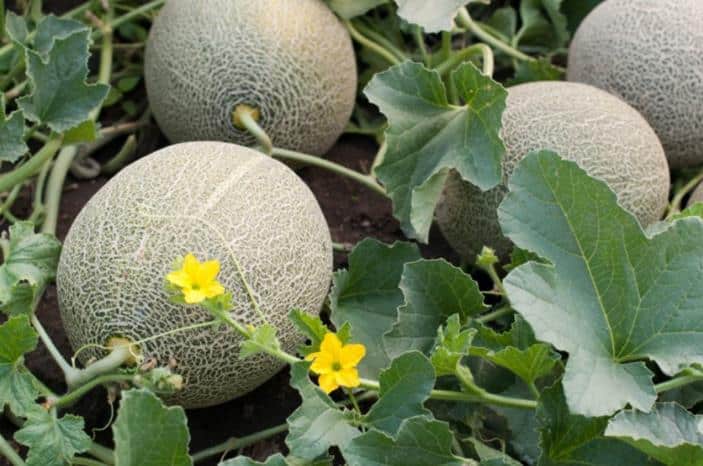Rabbits can eat fruits as occasional treats. Is cantaloupe ok for them, including the leaves, stems, and flowers?
Cantaloupe, sweet melon, spanspek, or rockmelon is one of the netted Cucumis melo (muskmelon) fruit variety in the family Cucurbitaceae weighing 0.5 to 5 kilograms. Other muskmelons include honeydew, Crenshaw, and casaba with smooth skin and Persian, Christmas, or Santa Claus melons with a netted skin.

There are two main types of cantaloupe, the European cantaloupe C. melo var. cantalupensis and the North America variety C. melo var. reticulatus. The former has a sweet and flavorful flesh and gray-green lightly ribbed peel, while the latter, which is popular in the US, Mexico, and parts of Canada, is round-shaped, with an orange moderately sweet flesh and a net-like peel.
Is it ok for bunnies?
Yes. Bunnies can have rockmelon or cantaloupe in moderation as a treat. Give them about a teaspoon per two pounds of their body weight, twice or three times a week. It is low in calories (34 calories per 100 grams) and a great replacement to the store-bought treats.
However, don’t go beyond the treat level since it is higher in sugar and carbohydrates while low in fiber. Too much may cause stomach upsets, gas, and diarrhea.
Benefits
It is nutritious. Rockmelon is rich in vitamins A and C and vital antioxidants that will help neutralize free radicals that cause cell and DNA damage and promote chances of inflammation and other diseases. It also has tocopherol, which is a potent antioxidant.
Also, vitamin A is good for eyesight, healthy red blood cells, and immunity. In contrast, vitamin C is vital in forming cartilage, muscle, bone collagen, blood vessels and may help diabetics or bunnies with certain kinds of cancer.
Also, it has other vital minerals and vitamins, including potassium, niacin, vitamin B6, thiamine, and dietary fiber, that will nourish the good gut microbiota.
If your furry friend doesn’t seem to like drinking a lot of water, a small slice of cantaloupe may help promote hydration since it is about 90% water.
Finally, giving your rabbits the same diet each day may make things boring. These fruits are a great way to introduce a new texture and taste – variety.
Cantaloupe plant- leaves, stem, and flowers?
If given no choice, bunnies will eat rockmelon. As SFGate put it, “cantaloupe fruit is one of the foods they will eat as pets, and that means you might find wild rabbits have been gnawing at the cantaloupe plants in your garden.”
Therefore, they may damage them. However, cantaloupes are not the most favored plants in y your garden together with others like squash, cucumbers, peppers, potatoes, as well as most of the herbs,
Instead, these animals will opt for flowers like roses, zinnias, and petunias, beans, peas, blackberries, carrots, strawberries, lettuce, among many others.
However, your home bunny may enjoy nibbling cantaloupe plants, leaves, vines, and flowers. For leaves, let it be part of their vegetable mix. A chopped cupful of 5-6 different veggies, including cantaloupe, are enough for a two-pound bunny.
However, for flowers, let them be only a treat. Remember, all treats shouldn’t provide more than 5% of their total food intake.
Feeding them
As we have seen, cantaloupes are safe for bunnies to eat. However, besides the amount which we have said should be about a teaspoon per two pounds of their body weight, here is what you need to observe too:
- Feed them plain, fresh cantaloupe, and not any other food that has other additives. Avoid spoiled or molded one you would throw into your dustbin.
- Its skin is known to carry harmful bacteria or microbes, including salmonella, thoroughly wash and scrub it to eliminate these pathogenic microorganisms. Any remaining fruit should be refrigerated to prevent the growth of any of these pathogens.
- Remove any seeds present as they present a choking problem and cut this melon into small dices to make eating much more manageable. However, you don’t have to remove the rind as it is safe, healthy, and more fibrous.
- If feeding them for the first time, begin with every tiny amount and gradually increase the amount to give your rabbit’s tummy time to adjust to the new food. Check for any diarrhea or stomach upset after a day. If none, continue increasing the amount.
Right diets
As hindgut fermenting animals, rabbits depend on diets high in fiber and low in energy like hay, which should be available unlimitedly. To help provide moisture and supplement nutrients, let them have 10-15% fresh foods, mainly veggies, and 5% high-quality pellets, while treats shouldn’t account for more than 5% of their food intake.
Remember that treats include all the non-leafy vegetables, fruits, flowers, herbs, and commercial ones you buy at your local store.
Conclusion
Cantaloupe is a delicious and nutritious fruit that you can eat as a salad, with custard, ice cream, smoothie, sorbet, roast, dessert or salad, or wrapped in prosciutto. You can also share a small piece with your bunny.
However, avoid giving rabbits seeds or overfeeding them since too much may cause weight gain since it has a considerable amount of carbohydrate (9g per 100g).
Finally, don’t give your baby rabbit below 12 weeks any fruits or vegetables, including cantaloupe. However, once they reach 12 weeks, you can begin introducing veggies and fruits slowly.
